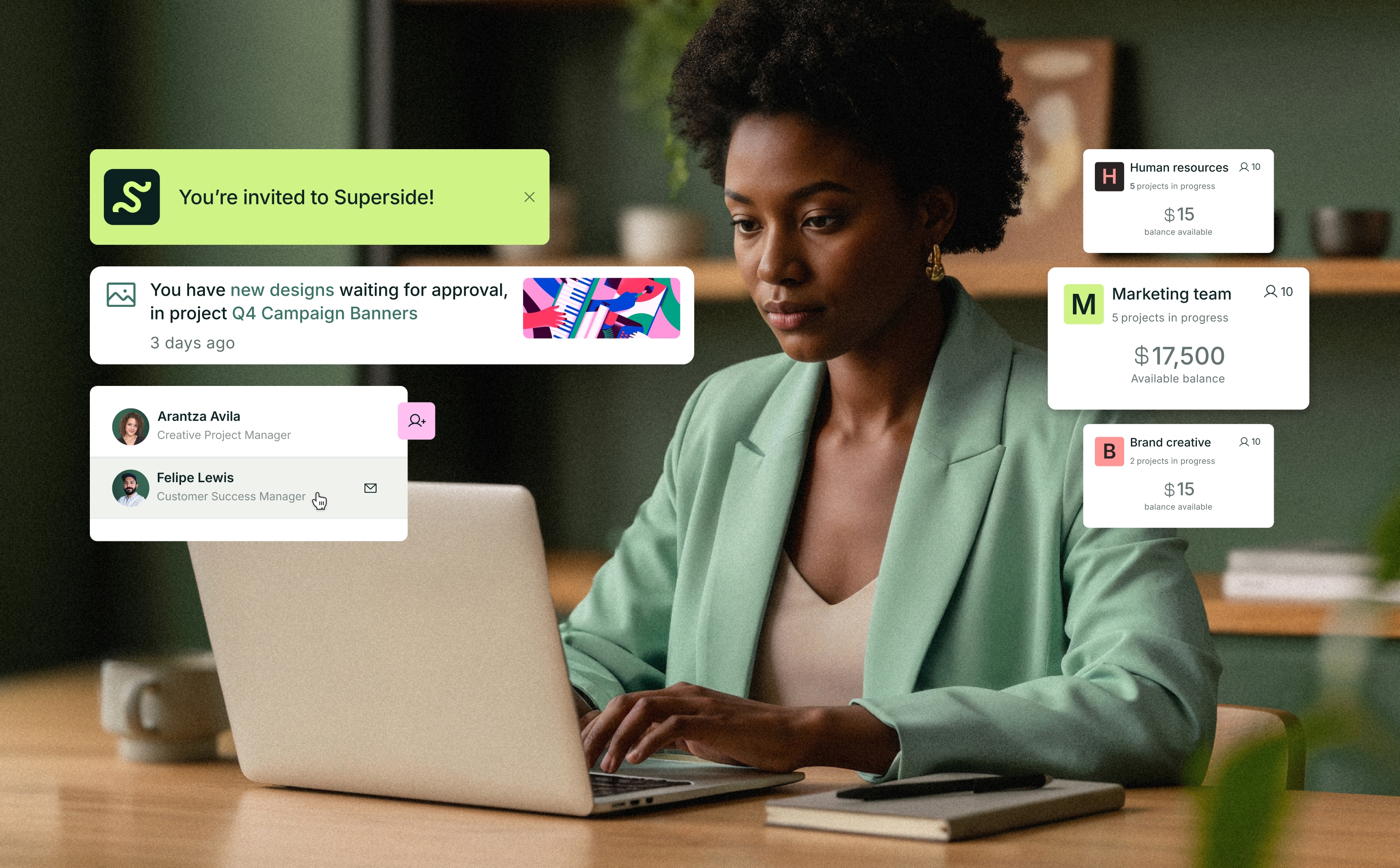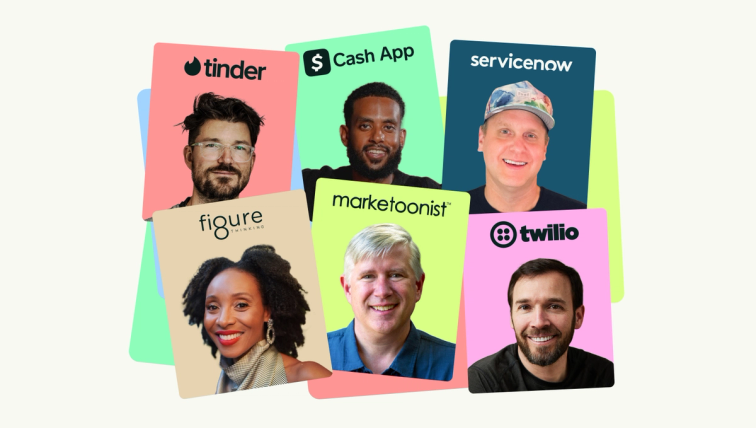
Learn how to identify burnout on your team in our previous blog, How to Identify Burnout on Your Design Team. See How Superside Cures (and Prevents) Burnout in part three of our series.
You’ve seen burnout at least once in your professional life: A team member with little left to give, slowly losing the will to persevere. Coworkers quietly rolling their eyes at one another. Every task is another item on a list that may as well be marked “Yeah, right”.
It’s a shame under any circumstance, but in creative work, it’s a tragedy. This is where people come to fill the hole that can only be accomplished by making beautiful, purposeful work. When burnout strikes a design team, it strikes the soul of that work. And without a soul, creative always suffers.
You’ve spotted a few signs of burnout on your design team. Maybe you’ve missed deadlines, or felt the onset of discomfort as a new project rolled in; fretting where it’ll sit atop the pile of other creative demands. Maybe you’re watching team members become less excited about their work as time goes on. Maybe your own tank’s nearly empty, and you’d rather drop the hypotheticals and get some answers before you’re stranded in the desert.
Here’s what you can do to stop burnout on your design team, and get back to making beautiful, purposeful work.
What You’ll Learn
Your Role in Addressing Burnout
How to Fix Burnout on Your Design Team
Treat Symptoms of Burnout Individually
When Design Leaves Burnout Behind
How to Spot Creative Burnout
In the professional world, burnout is a state of perpetual exhaustion in one’s work. It’s especially degenerative on design teams, comprised of creatives whose work demands peak performance to be effective. If they’re not satisfied with their work, the marketing department likely won’t be either.
There are ways to spot creative burnout, but you’ll need to know what you’re looking for.
Remember these cute fellas? Take our Burnout quiz, and see where your team lands on the Burnt Toast scale:
For more tips on identifying burnout on your design team, check out our previous blog, How to Identify Burnout on Your Design Team.
Your Role in Addressing Burnout
Burnout is seldom one person’s “fault”. It’s usually a structural issue that’s accumulated over time, like a snowball rolling down the Swiss Alps. Teams take on an ever-growing list of responsibilities: When the workload appears easily manageable, decision-makers may assign more duties for fear of wasting marketing dollars. The team manages with less ease, but still technically moves forward. This process can repeat itself over months or years, until being stressed out is the norm.
But while no one needs to beat themselves up over it, it’s the responsibility of creative leads and senior marketers to eliminate burnout when it shows up. Whether you’ve spotted some telltale signs on your own, or have had team members express dissatisfaction with their workflows and work—leadership is on the hook to ensure well-being and peak performance on design teams.
How to Fix Burnout on Your Design Team
Burnout doesn’t have to be the end of a functioning design team, but it can be if left untreated. Like a rash, it’ll keep spreading until it’s inflamed and visible to everyone in the office.
Take note: This is not a feel-good list of self care tactics that puts the burden of burnout on your team members. Outside of this disclaimer, there will be no mentions of guided meditation sessions, nifty time management tricks or stocking the lunch room with CLIF bars. What follows are concrete steps to a happier, more effective design team.
Talk to your design team about burnout.
When there’s a problem, the first step is always communication. You may have assumptions about how others may be feeling, or about what’s causing the burnout. Maybe you’re 99% right, maybe you’re 45% right. However on the ball you are, you can guarantee you don’t have the whole story.
To start, you’ll need to set the stage for an open and honest discussion. Book one or two hours to talk about burnout on the team. This is a crucial tactic: Make it clear you’re going to talk about burnout. This is not a “check-in”, or a “watercooler” moment—you’ve seen signs of burnout and are here to address it specifically. Ensure that everyone is aware of these three things:
- Though the ideas shared in this discussion may be shared with senior leadership to address the problem, team members will remain anonymous. This will be design speaking as a collective.
- There will be zero repercussions for any feedback shared in the meeting. The meeting is happening because processes and structures have failed the team.
- You will do everything you can to rectify this. As such, 100% honesty is needed from each team member about what workflows and processes are causing problems for them.
Do more listening than talking.
When it’s meeting time, your role will be that of the facilitator—not the problem solver. That comes later.
Listen deeply and refrain from providing any of your own opinions/responses until everyone feels they’ve been heard. To do this, it may be helpful to either have someone take notes (don’t try to take notes yourself while listening, it limits your intake and participation) or consensually record the session for your own review afterward.
We’re not as good at listening as we think we are, so practice empathetic reflective listening (ERL) to make sure you’re engaged. This involves “playing back” what they’ve said to check that A) you’ve understood what they’ve said without putting your own spin on it, and B) they feel that they’ve been heard and understood by leadership. When they share their thoughts on what’s burning/burnt them out, summarize them out loud and ask if you’ve understood them.
As a facilitator, be sure to keep the conversation in the pocket of burnout. It can be tempting to treat it as an opportunity to air every work-related grievance, so respectfully rein it in if you find yourselves discussing the office new year’s party.
When wrapping things up, ask if everyone feels their concerns have been heard. When you’ve got the green light, close out the meeting by letting the team know how you’ll proceed with this information.
Review, compile and share your team’s feedback.
While the biggest culprit is typically “too much work, too little time”, you may be surprised to find how varied your team’s concerns are. Beyond the workload, burnt-out design teams frequently cite lack of control over projects, lack of growth opportunities, too much ambiguity around projects/their role, or general boredom with their work.
Compile these concerns in an easily accessible document, and share it with your team for feedback, additions and elaboration. Keep it handy, as you may need to share it with other stakeholders if concerns exceed what you can personally address.
Determine which problems you can personally address, and advocate when you can’t.
If you’re in a senior or leadership role, you have more power than you may think. You have a bigger say in which projects get priority, how design is budgeted, who gets assigned what, and how stakeholder relationships are managed. You may find that with the right tweaks here and there, work becomes simpler for all involved. We’ll explore some specific solutions below.
Where problems exceed your direct action, be a relentless advocate for design at your business. Recognize your role as a valued creative leader, and use your weight accordingly. You’re not just the person who tells their team what to do, but the one who tells stakeholders what you need.
With some light editing for executive eyes, share your team’s struggles with those who need to know about them. Make clear the effect burnout has on your team, but how those effects are either hurting or will soon begin to hurt business goals.
- Missed deadlines are affecting marketing goals
- Rushed assets perform more poorly
- Ambiguous/overly-flexible briefs require numerous edits that waste marketing dollars
- An overwhelming workload is resulting in or risking designer turnover (and it’s expensive to replace them/train new designers)
These are figures that stakeholders care about (or can be taught to care about), so think about how each complaint can be tied to dollar value. It’s cynical, but it’s necessary. With this, outline the wins for better resourcing in design: How addressing these problems will benefit stakeholders. With a bit of digging, you can build a short and compelling case for proper resources and modifications.
Treat Symptoms of Burnout Individually
Different burnout symptoms require different approaches. Clearer briefs won’t solve designer boredom, and varying projects between designers won’t reduce workload (although that is definitely something Superside could help you with). Here’s how to treat the common symptoms of burnout on creative teams.
1. Too much work, too little time.
This won’t be the only thing you’ll hear, but you’ll probably hear it the most. The most common cause of burnout is projects coming in faster than they can be completed. Fixing it often requires reframing how the design team operates.
How to fix it
Your design pipeline needs to tighten. If designers are struggling to pump out the best creative they can summon on a reliable basis, there are two options available to you (assuming putting out crappy creative isn’t an option):
A) Let the necessary teams/stakeholders know that the current design pipeline is unmanageable, and hurting both productivity and performance. Outside teams may do what they can to alleviate the workload, though there’s no guarantee.
B) Use dedicated design services (like us!) to take on the overflow, and let your team focus exclusively on high-priority projects. There are teams of design professionals and brand stewards that exist solely to take on projects that ambitious design teams and businesses can’t afford to tackle on their own.
When adding new designers is expensive and time consuming, many high-performing teams lean on these partnerships to develop compelling, brand-strengthening creative that upholds marketing goals while giving your team permanent breathing room.
2. Lack of control over creative projects.
While there’s a clear hierarchy within your team, not giving designers the freedom to experiment with new ideas or techniques is a surefire way to kill their enthusiasm for their work. There are brand guidelines to consider, but don’t be so rigid as to forget why you hired specific team members: You trusted their creative instincts and capabilities. Remember that creativity and progress come almost exclusively from thinking—all together now—outside the box.
Likewise, designers may resent not having control over which projects get put on their plate. Maybe they’ve been assigned design projects unaligned with their skill sets (they enjoy brand identity work, but are slogging through images for socials). Maybe certain projects require more time than others, but given timelines ensure it’ll be a rush job.
How to fix it
Give more airtime to creative suggestions. You don’t need to blindly greenlight every passing thought, but you do need to trust your designers and be willing to let them experiment. In creative fields, results are what determine an idea’s efficacy. Strict, immovable guidelines are for the accounting department.
Help your designers clear their plates by being strategic about who gets what. Mixing things up once in a while is good for novelty, but talent should generally be deployed based on skill sets. As long as resulting creative isn’t way off the mark, encourage designers to be the god of their own universe, and only pull the reins when it’s absolutely necessary to do so.
Implore them to give you personalized timelines for each new asset based on their existing workload and project demands, and find a reasonable compromise if need be.
3. Too little clarity around projects/roles.
Unfortunately for designers, project briefs are often either too vague (leaving so much room for interpretation that whatever they make isn’t sure to meet the imagined criteria), or too scattered to make sense of (“it should be loud and proud, but subtle and elegant”, etc.). Even further, graphic design jobs descriptions are often so ambiguous they may as well read “make pretty.” Though a bit of leeway is nice, too much results in excessive revisions, wasted time and burnt-out designers.
How to fix it
This is where you’ll need to make a stand for your team: Stakeholders need to understand that briefs must be laser-focused in their intentions for each asset. Not in their methodology, mind you… leave the designing to your team. Get them to provide you with brief instructions for what they want every given asset to communicate, and be the mediator if/when confusion arises.
If team members feel confused about the work they’re doing vs. the work they thought they’d be doing, either show them how their work supports the goals outlined in their job description (assuming it’s appropriate to do so), reset their stated responsibilities (and possibly title) to match the work they’re actually doing. Read more about this in section 5.
4. Boredom with creative projects.
Boredom strikes everyone at some point. Even professional ice cream tasters have days where they’d prefer a cheetoh. The question is not “do you get bored”, but “are you most often bored in your work". If your designer affirms the latter, there’s work to do.
How to fix it
Ask your designer where they feel their skills could be put to better use, and find ways to include better-aligned projects in their workflow. This usually doesn’t necessitate a complete overhaul of their responsibilities; mixing in enough fun stuff should make the occasional tedious tasks easier to stomach.
Boredom and lack of creative control often go hand in hand, so pick from the solutions outlined in that section if necessary.
5. Lack of growth opportunities.
If a designer’s been around for a while—doing the same things with the same title and for the same compensation—they may start to wonder if staying where they are is hurting their career. There’s been a “talent war” in recent years, and they know many businesses would love to have them in their corner.
How to fix it
It’s far easier (and cheaper) to retain an existing employee than it is to replace them. Listen to their concerns and ask yourself: Where in the business could they be doing more? Are there other design needs they could fulfill? Is their title representative of the duties they perform? Are they being paid at least market rate for their role? Don’t make assumptions about that last one, either—take a look at LinkedIn and other job search sites to see what they could be making.
Having asked yourself these questions, talk to your designer about what space can be made for their capabilities. If you’re unsure the available opportunities are right for them at the moment, set clear expectations for what you’d need to see from them to consider it.
Recognize the biggest source of burnout.
While all of the tactics above can help eliminate burnout, we’d be remiss not to point the finger at overwhelming workloads as its primary source. It’s what comes up the most when cornering burnout in general, and it applies equally to design teams. Favor solutions that either eliminate or—more likely—redirect design overflow.
When Design Leaves Burnout Behind
Stressed, overworked and overdue doesn’t have to be the norm for design teams. There are ways to work through burnout—some more simple than you’d think. The easiest way to lighten the load without adding heads or compromising on quality is to partner with a dedicated design team like Superside.
Professional design services can more affordably catch the overflow while turning over high caliber brand assets, giving you the headspace and brand stewardship that doesn’t just beat burnout but improves your design team’s workflows permanently.
When design teams leave burnout behind, marketing goals are met, teams are happy in their work and powerful creative flows like water.














